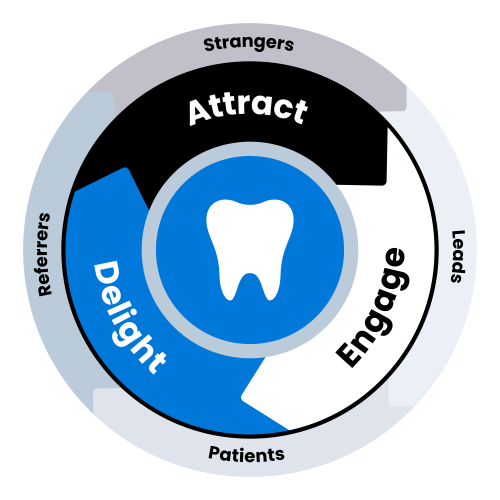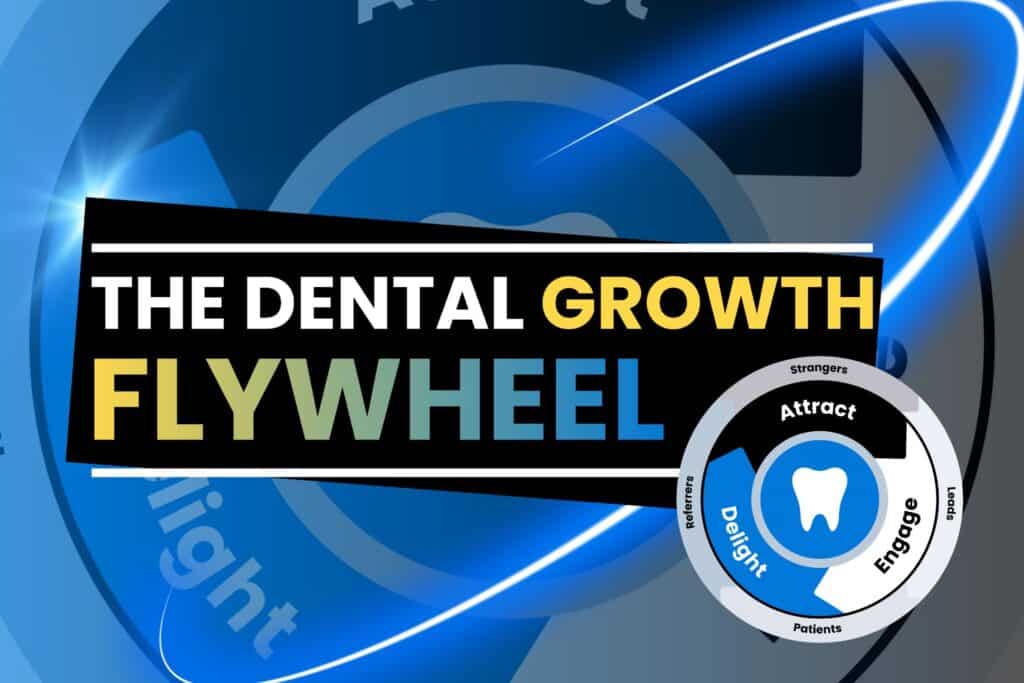Dental marketing is an essential tool for generating new patients. Only marketing can give you predictable, scalable new patient growth — which is especially valuable for dentists looking to navigate rising interest rates, boost revenue, add specialties, or expand to new locations.
But the truth is that not all marketing is created equal. Some dentists throw a bunch of haphazard ideas at the wall and hope that something sticks. Others might invest smartly in one area — say, ads — but throw away money on poor conversion.
Don’t be like those dentists. Using our growth flywheel model, you can create a comprehensive dental marketing strategy to reliably create, convert, and close more new patients.
Whether you’re building an internal marketing team or looking for an external growth partner, keep reading to learn how to:
- Attract: Generate more leads
- Engage: Turn more leads into patients
- Delight: Keep more patients coming back (and get them to refer their friends)
The growth flywheel model
Here’s the basic flywheel model:

As you can see, each phase of the flywheel drives energy into the next. And the key is that as you get better at each phase, the wheel will actually gain momentum, helping you generate more new patients while maintaining the same levels of growth spending.
Attract = generate leads
The attract phase is what you’d probably call marketing. This is where you use tools like ads, social media, and referrals to create leads and get them to contact your practice(s) looking for an appointment.
Here’s how you do that.
Search engine marketing (SEM)
SEM is marketing-speak for strategies that will make your practice(s) appear when potential patients google “dentist near me”. Let’s tackle the two main options: paid and organic.
Paid search
Paid SEM means running ads on Google. Your ads will show up on search engine results pages (or SERPs) for top keywords used by people in your community looking for a dentist. The goal of your ad campaign is to reach people searching for your specific services and drive them to your website.
Google ads are pay-per-click (PPC). You won’t pay Google a dime to display your ads, but you will pay them every time someone clicks on one.
To make this work for you, you’ll need to carefully target your ads — otherwise, you’ll waste money paying for clicks from folks who are never going to show up in your waiting room.
In our experience, when done correctly, paid ads generate the fastest, most consistent, and most predictable new patient growth.
Organic search
Organic is about ranking highly on key SERPs without buying ads. The key to doing this is search engine optimization (SEO).
Think about what happens every time you google something. Typically, the first results you see are paid ads with a white “sponsored” tag above them.
However, scroll down a little and you’ll see search results without the “sponsored” tag. These are organic results that are ranked based on Google’s algorithm — and you don’t have to pay Google anything to be one of them.
But ranking well for SEO isn’t usually easy. At a minimum, you’ll need to make sure your website is properly optimized. You may also have to invest in producing content that will help you stand out relative to other practices competing for Google’s attention.
We think you should use SEO as a secondary strategy behind paid ads. While valuable, it often takes a year or more to start producing significant growth and will never be as predictable as leads generated by ads.
You’re also vulnerable to any changes in the algorithm, which can affect your ranking without notice.
Social media marketing
As with SEM, your best bet to generate patients through social is by using paid ads — specifically on Facebook.
This may feel counterintuitive, given that so many companies turn to social media to create organic buzz. However, the vast majority of those are national brands, not local businesses.
The problem here is that as you grow a social media following, the vast majority of your followers will likely not be in your immediate geographic area. As a dentist looking for patients within a single city or town (or even a neighborhood), you’re going to have a very hard time getting any real new patient growth by posting clever videos on your Instagram or TikTok.
(One organic tactic that can work is becoming active in Facebook groups aimed at people living in your city. Being a regular contributor in say, “Cinncinati Moms,” will get you in front of folks who could actually end up in your waiting room. Make sure, though, that whatever you’re posting is of real value to the group.)
But you can see real results by running Facebook ads. You can target these to reach only local users and draw eyeballs from potential patients at the very top of the marketing funnel — the ones who haven’t even gone to Google yet.
Conversion-optimized website
The goal of your website is to take traffic from your ad campaigns and turn it into phone calls or messages to your front desk. How well your site is optimized to do this will play a major role in your overall new patient results.
Done wrong, you’ll wind up pouring your marketing dollars down the drain by driving leads to a page that kills their excitement or makes it too complicated for them to contact your practice.
Typically, you’ll want a clean, contemporary design that highlights five things:
- Services and treatments
- Doctors and team
- Specials or new patient offers
- Testimonials from existing patients
- CTA buttons that make it easy to schedule online or call your front desk
Don’t forget to include friendly photos of your doctors and team on your site. This will go a long way towards building trust with patients who may suffer from dental anxiety, making them feel more comfortable about showing up for an appointment.
And like we said above, while SEO shouldn’t be your main digital marketing strategy, you do want to make sure your site itself checks all the basic SEO boxes.
Retargeting
Retargeting is running ads to people who have previously visited your website. These folks are considered warm (or at least warmer) leads because they’ve already expressed an interest in your services.
This means that re-engaging them through additional ads has a higher likelihood of converting them into a lead. Typically, you’ll retarget on Facebook or other social platforms, although it won’t hurt to invest a little in Google as well.
You can also use this same strategy to reconnect with existing patients who haven’t been in for a cleaning in a while.
Referrals
Referrals are really important. Ideally, they should make up roughly 50 percent of all your new patients — without costing you any of your growth budget.
We’ll go into referrals in much greater detail when we reach the delight phase. For now, this is just a reminder that in addition to all of the paid strategies we’ve just covered, free marketing also plays a big role in your overall growth.
Engage = turn more leads into patients
Too many practice leaders think that marketing stops once a patient contacts your practice. But that just means you’ve entered the engage phase, or when things actually start kicking into high gear.
Here’s how you take those patient contacts and consistently turn them into scheduled appointments or starts.
Conversion
For every 10 leads that call looking for an appointment, the average dental practice will schedule four to six of them. This means that many practices are wasting up to 60 percent of all leads created by their marketing campaigns simply through poor phone conversion.
In other words, helping your team get really good at turning phone calls into appointments is one of the most powerful ways you can boost your overall growth. Improving your conversion rates is a low-hanging fruit that will pay off big in the long run.
Typically, you’ll need to:
- Record all your new patient phone calls.
- Listen to them to assess phone performance and identify areas for improvement.
- Review feedback with your call team.
- Work with outside conversion coaches when necessary.
Do this, and you can often boost your conversion rate to 80 percent or better. Plus, those results tend to be long-lasting. Once your call team has gotten really good at converting, they’ll often retain those skills for the foreseeable future.
Scheduling
One huge mistake that many practices make is scheduling new patients too far out. Most people don’t want to wait six or seven business days to see a dentist — and if you make them wait that long, they’ll schedule somewhere else and won’t show up.
Ideally, you want to see every new patient sitting in your waiting room within 72 business hours of their first call to your front desk. On its own, this will dramatically reduce no-show rates (more on those in a moment).
To reduce your wait times, try blocking off slots on your doctors’ schedules and setting them aside solely for new patient appointments. That way, you’ll always have space to see someone quickly.
(This will cost you some flexibility with returning patients, but since you already have a relationship with them, they tend to be willing to wait a little longer for an appointment.)
No-shows and same-day cancellations
Practice leaders have always struggled with same-day cancellations and no-shows, but the problem seems to have gotten worse in recent years. Whether due to financial pressure or dental anxiety, patients may schedule needed treatment and then back out at the last minute — with or without giving you any notice at all.
Two tactics that can be extremely helpful here:
- Double booking. If you don’t get a response to your confirmation text or call, go ahead and double-book that slot. Nine times out of 10, the first patient won’t show up (and if they do, politely explain that you didn’t hear back from them and had to fill the space. Squeeze them in if you can and smooth things over with a Starbucks card if necessary.)
- Doctor check-in calls. Before a new patient’s first visit, especially, have one of your doctors give that patient a short call to see how they’re doing, answer questions, and talk about any concerns they may have. This is a great way to begin building relationships and help patients feel safer showing up for their appointments.
Implant lead nurturing
Implant marketing is not like other dental marketing. Unlike people who are looking for a filling or a replacement crown, most implant patients take months or years to research treatment options before they show up for a consult (and even then, they may not be ready to say yes).
This means doctors who want more implant or full-arch cases need to have a lead nurturing system in place.
Here, you want your ad campaign to funnel leads to complete a web form providing their contact details and requesting more information about dental implants. Then you’ll need someone on your team to follow up with each lead on the phone within two weeks of getting their number.
Depending on their level of interest in scheduling a consult, you’ll either need to continue following up on the phone regularly (if high) or put them into a drip email campaign (if low). The overall goal is to build a relationship with a lead until they’re actually ready to come into your office.
Because implant patients tend to be older, you may also want to embrace unconventional strategies like live events in retirement communities in order to reach them.
Delight = keep more patients coming back (and turn them into referrers)
Congrats! You’ve officially turned a stranger into a lead and a lead into a new patient. Now you’ve reached the delight phase, where your goal is to turn that new patient into a regular — and referral source.
This phase is all about getting the most value out of the marketing work you’ve already put in during the previous two phases. Done correctly, your efforts here will lock in your existing successes and drive the wheel back into the Attract phase to generate new growth.
Recare and retention
This is number one. You’ve invested significant time and money into using marketing to create a new patient — but for most (non-full-arch or ortho) practices, you’ll only see a significant ROI if that patient keeps coming back for regular hygiene appointments or additional care down the road.
That’s why focusing on recare or retention is so important. This starts by making an effort to build a relationship with every patient who comes through your doors. Take the time to listen to what they have to say (just about everybody wants to be heard), understand their concerns and their fears, and show them that you genuinely care.
Just doing that will take you a long way. But don’t forget smaller stuff, like always making sure a patient schedules their next appointment before leaving your practice and sending a reminder or confirmation text when the big day is almost here.
Reviews
Let’s not beat around the bush: The more 5-star Google reviews you have, the better. These do everything from building instant trust with potential patients to improving your SEO and are essential to helping you stand out from the competition at a glance.
Fortunately, the key to getting more reviews is really simple: Ask. Consistently. Oh and make sure that before you do, you’ve offered the level of service that makes people really eager to say yes.
Here are three tactics we like that can help boost your review count:
- Go over any new reviews during your morning team meeting. This creates buy-in and helps your whole team feel invested in both positive and negative feedback.
- Create a scoreboard to track which team members or locations generate the most reviews. Many people are motivated by competition. Give them a way to keep score and they’ll strive to reach number 1.
- Reduce friction by making it really easy to leave a review. Try setting up your reputation management system (more on that below) to automatically text them a review link 1-2 hours after an appointment, while you’re still top of mind. You can also put up QR codes in each operatory that they can scan to leave a quick review — and give each patient time to actually write the review after you ask by stepping out of the room for a few minutes (you can come up with a polite excuse to do this).
You can also use a third-party review platform to make collecting reviews even simpler.
One key note: If you want to encourage patients to leave reviews while they’re still in your office, don’t give them access to your wifi network. Google will flag all of their reviews as coming from the same IP address.
Referrals (again)
We can think of reviews as a valuable passive source of referrals. But active referrals — an existing patient recommending you to friends and family — can be even more valuable.
As with reviews, the key here is to provide great service and then ask. Don’t be afraid to encourage your doctors and hygienists, especially, to encourage happy patients to refer other people in their social circles.
Framing the request as relational makes it more likely your patients will follow through. “Would you do me a favor…?” is a powerful way to start — after all, who doesn’t like to be helpful?
You can also consider offering gift cards or free whitening sessions to patients who deliver on referrals.
Retarget existing patients
We touched on this in the attract section, but it’s worth mentioning again here. Since existing patients already trust you and have a relationship with your practice, they’re going to be cheaper to re-engage than new leads.
That’s why you should run ad campaigns on Facebook or other social platforms retargeting those patients. Create a list of patients who are, say, six months overdue for their last cleaning and retarget them specifically.
Also good (and cheaper than running ads):
- Sending text or email messages reminding current patients that they are overdue for their next cleaning.
- Seasonal email campaigns (with a special offer) for holidays, back to school, graduation or wedding season, and other time-sensitive events.
Each of these can be an effective way to quickly gin up some revenue.
Tracking key data: The straw that stirs the drink
Now, we’ve gone 2,500-ish words on strategy and tactics without really mentioning the engine that drives it all — analytics. If you’re going to implement an effective attract, engage, and delight approach, you need to be able to track how you’re performing through every stage of the flywheel.
High level, this means knowing essential benchmarks, like:
Attract stage
- How many leads you’re creating
- Your cost per lead
Engage stage
- How many of those leads become new patients
- Your cost to create each new patient or cost per start
- Unanswered call rate
- Phone or chat conversion rate
- Average time to start
- No-shows and cancellations
Delight stage
- Retention and recare rates
- Number of Google reviews
Each one of these metrics gives you powerful insight into how you’re performing on different stages of the flywheel. Together, they paint a complete picture that will help you identify problem areas and optimize your entire new patient journey to lower your per-patient costs and boost growth.
We track this stuff automatically for each of our clients. But you can also do it on your own, pulling data from your ad dashboards and PMS as well as recording and monitoring your phone calls to get a clearer picture of everything from what you’re paying to generate a lead to how well your team is converting those leads into scheduled appointments.
SMC = Attract, Engage, and Delight👇
Congrats on making it this far. Everything you’ve just read through is part of what SMC does for dental practices — the complete dental growth flywheel in one powerful growth partner.
Book a demo to share your goals and learn if we’re a good fit to deliver serious growth for you, too.👇






